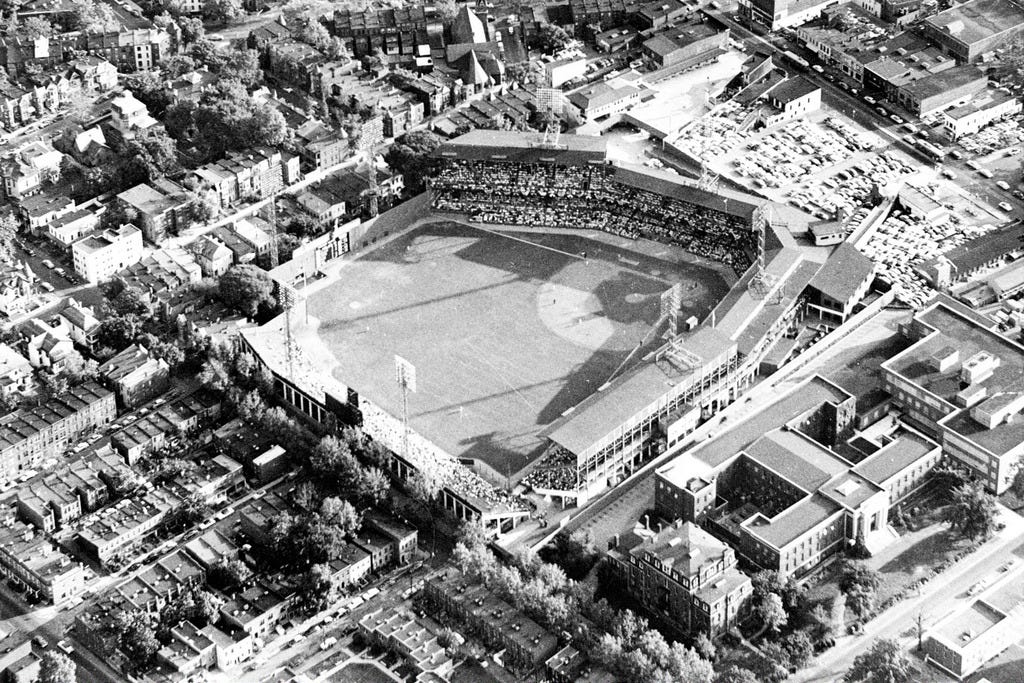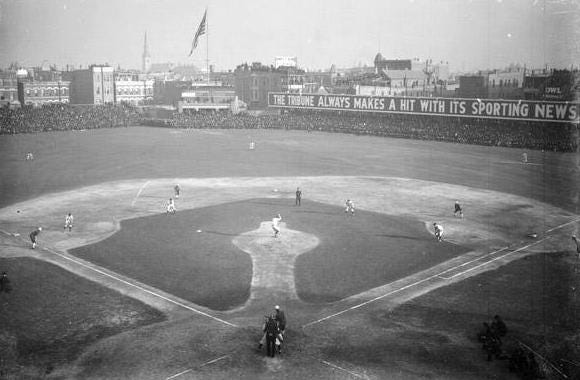More Than You Needed To Know About Inside-The-Park Walk-Off Home Runs By Catchers
One of the weirdest old stadiums in baseball history is prominently involved

On Tuesday night, Patrick Bailey of the San Francisco Giants did something that really almost never has happened. He hit a walk-off three run homer, which is not that unusual, but it was an inside-the-park walk-off three run homer. And not only that, but Bailey is also a catcher. Bailey is the first catcher to have an inside-the-park walk-off homer since the Washington Senators Bennie Tate on August 11, 1926.
So of course, never having heard of Bennie Tate, I looked him up, and his inside-the-park walk-off homer is even stupider, somehow, than Bailey’s. He was a backup catcher on those Senators, just 24 years old. Since they were pretty much out of the race at that point, just treading water around .500 while the Yankees were 30 games over and in first place (remember, no wild-cards in those days), Tate was getting a lot of work behind the dish. He’d caught the entire game the day before, and this walk-off happened to end the second game of a doubleheader that went to 11 innings.
So, Bennie Tate hit his inside-the-park walk-off homer after catching 29 innings in less than 24 hours. And what was his reward for this? He caught the entire game for the next four days- with another doubleheader in there as well. That’s six consecutive days catching all eight games, a total of 65 innings, with the walk-off homer in the middle. It was his only extra-base hit in that span, but he did have 10 total hits in 26 plate appearances…
Of course, it was also his only home run of the season. There is obviously no film of the play, so all we have to go on is the description, which says the ball was hit to the center field/right field area of old Griffith Stadium, which was one of the bigger ballparks of the old days.
At this time, the right field wall was 328 feet away from home plate, with a dramatic angle to reach right-center, which was 457 feet away, before a crazy turn to get to actual straightaway center field which was 421 feet away. These dimensions occurred because the people who owned houses in that area refused to sell when the park was being planned, so they built the park around them and the big tree they had.

So, it seems likely that Tate’s ball went somewhere in that weird area and caromed around while he went around the bases. The Senators were playing the New York Yankees that day, and their right fielder was not the fastest man around and it was the middle of August and the second game of a doubleheader, so he was probably not chasing the ball around at tip-top speed. You hadn’t heard of Bennie Tate before this, but you’ve assuredly heard of the Yankees right fielder, a fellow named Babe Ruth…
Ruth might also not have been going at full speed because two years before he had been chasing a fly ball in that same Griffith Stadium right field and knocked himself out on the low concrete wall near the foul pole…
Bailey became the third catcher to have an inside-the-park walk-off homer since the modern era began in 1901. While Tate was the most “recent” before this, the first to do it was Pat Moran in 1907. It was pretty easy to find which game, because Moran only hit one home run that season as well. It was August 4th, and the Chicago Cubs hosted the New York Giants. And like Tate’s, it was extra innings, in the the 12th as it happens. And Moran hit it off future Hall of Famer “Iron Man” Joe McGinnity to boot.
(Moran was the Philadelphia Phillies manager in 1916, which gives him a prominent role in my book on the longest winning streak in baseball history by those New York Giants, for sale on Amazon, and it’s Prime Days, so you should get the paperback… there’s no excuse, really…)
(And who did Patrick Bailey hit his inside-the-park walk-off home run against? Why, the Phillies, of course…)
There’s even less information about this game available than Tate’s to figure out where Moran’s ball went, but since it was 1907, we know the Cubs weren’t playing at Wrigley Field yet- their home park was still West Side Grounds. And we know that center field was almost 450 feet from home plate, and right field was about 310 feet away or so, so there’s another dramatic angle that could swallow up a ball. So, it’s reasonable to assume Moran’s ball went around there. And yeah, even a catcher who’d caught 39 innings in the last four days had a chance to go all the way with a ball that went to that part of the yard…

Bailey’s home run came inches from actually going out of the yard for a rather conventional walk-off three-run homer. Statcast says it would have been a regular home run in 29 of the 30 parks. You know the exception, because that’s the one he hit it in. And if it had been just a few inches longer, we’d never have a reason to know about Bennie Tate…
But that is just how the ball bounces… sometimes goes all over the place and a catcher can just keep running into the history books…
It makes what Lawerence Butler did in West Sacramento for the Nomads (aka, the A’s), seem almost ordinary. Butler led off Tuesday night’s game with an inside-the-park home run of his own- swinging on the very first pitch- becoming the first “A” to do that in 82 years- not even the most prolific leadoff home run hitter of all time, Rickey Henderson, did that.
The last guy to lead off a game for the A’s with an inside-the-park home run was a fellow named Elmer Valo, a Slovakian-born outfielder.
And you’re not going to believe where the A’s played on June 25th, 1943.
Yep, Griffith Stadium. And the play-by-play says Valo’s hit went to “center field.” So we know what kind of an adventure THAT was…
And with that in mind, you must have figured out the punchline. Tuesday was the first day in MLB history to have both a leadoff inside-the-park home run and a walk-off inside-the-park home run. Not even Griffith Stadium could match that feat…




Nice piece, Alex. It was loads of fun to watch the end of last night's game. Anything, almost, can happen and that's one of the things that makes baseball special. I had Elmer Valo's Topps card back in 1957. I wonder if I can embed it here. We'll see...Nope.
The most enjoyable article following the craziest carom I have ever seen and one of the most surprising and unexpected finishes ever!
Now if the ball had deflected off the brick wall into the bullpen or the stands, well, not nearly as much fun. And, we would not know about Bennie...or learn more about Griffith Stadium...or discover Elmer...a game of centimeters. Kudos to the architect and to resistant homeowners.
Coincidentally, reading Ballpark: Baseball in the American City. Most of the urban ballparks built at the turn of the last century featured dimensions that were governed by the city block layout or available land. Griffith was not alone.
Go Bennie!